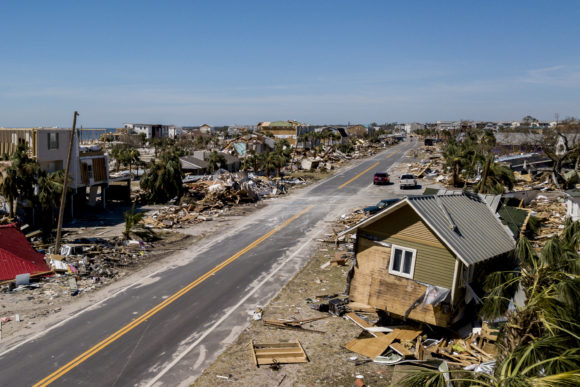Since Hurricane Michael made landfall Oct. 10, 2018, federal assistance for recovery in the 18 affected counties is nearly $1.9 billion, including FEMA grants, National Flood Insurance Program payments and U.S. Small Business Administration loans, according to a statement from FEMA.
Included in that figure is an estimated $224.1 million in claims paid to 4,270 NFIP policyholders, FEMA said.
One year has elapsed since Hurricane Michael pummeled the Florida Panhandle, packing 155 mph winds, torrential rain and high tides and displacing thousands of families amid structural damage that will cost billions to repair.
Twenty-five federal and 29 state agencies responded to one of the country’s most powerful storms. In addition to state and federal agencies, the local governments, community leaders, voluntary and faith-based organizations and private sector partners contributed to hurricane recovery efforts.
FEMA said federal assistance for Hurricane Michael, as of Sept. 30, 2019, includes:
- Nearly $319.7 million approved in FEMA Individual Assistance:
- Nearly $121.3 million approved for housing repair costs, home replacement and rental payments.
- Nearly $19.7 million approved to replace essential household items and for other critical disaster-related costs.
- More than $70.2 million provided to FEMA’s direct housing program for purchasing housing units, renting housing pads and unit maintenance.
- Nearly $51.8 million approved for immediate disaster services including food, water and emergency sheltering.
- More than $56.7 million obligated for crisis counseling, disaster case management, disaster legal services and disaster unemployment assistance.
- 31,386 households were approved for housing assistance and other disaster-related costs such as home repair, rental assistance and replacing essential household items.
- From October 2018 to April 2019,2,058 displaced households received hotel lodging through FEMA’s Transitional Sheltering Assistance program, totaling $16.7 million in assistance. The program ended in June and more than 2,000 households were provided lodging at no cost as they pursued and successfully secured permanent housing options.
- 925 households have participated in FEMA’s direct housing program, which provides travel trailers or manufactured housing units on private property, in mobile home parks or at FEMA group sites. At present, 284 households have successfully moved on to more permanent housing by completing basic home repairs or finding a rental property.
- The U.S. Small Business Administration approved 12,730 low-interest disaster loans to homeowners, renters and businesses for more than $644.7 million.
- Nearly $496.6 million in Public Assistance grants approved for Hurricane Michael-related reimbursements to state and local governments and certain nonprofits, including:
- $283.2 million for debris removal (32.9 million cubic yards of debris removed, according to designated county reports from U.S. Army Corps of Engineers [USACE]).
- $181 million for emergency protective measures.
- $32.4 million for permanent repair work.
- Under a mission assignment from FEMA, USACE installed 7,800 blue roofs, enabling families to live in their homes while making permanent repairs.
- FEMA deployed staff to support survivors before, during and after Hurricane Michael made landfall. At the height of the response in mid-November, more than 1,220 federal employees were assisting with response efforts. FEMA has hired 68 local Floridians to assist with response and recovery efforts.
In addition, FEMA’s Interagency Recovery Coordination Group continues to work with the state and the designated counties and their communities to help identify and coordinate financial and other resources to meet needs beyond what FEMA, the state and other programs can cover.

Seven long-term recovery groups have been formed across the Panhandle to address unmet needs of survivors in their communities.
“As the costs of disasters continue to rise, governments and residents must find ways to reduce hazard risks to our communities,” FEMA said in a statement.
Under the presidential declaration for Hurricane Michael, all areas within the State of Florida are eligible for assistance under the Hazard Mitigation Grant Program (HMGP). HMGP funding helps communities eliminate or reduce future disaster-related damage. In general, individuals may not apply directly to FEMA for HMGP funding, but may be sponsored through a local government, tribe or private nonprofit. All applications from local governments or others are submitted to the state, which receives and distributes HMGP funds from FEMA.
Source: FEMA
Topics Catastrophe Natural Disasters USA Hurricane FEMA
Was this article valuable?
Here are more articles you may enjoy.


 New Hampshire to Offer Mobile Driver’s Licenses
New Hampshire to Offer Mobile Driver’s Licenses  Wall Street Backs LA Wildfire Lawsuits, Chasing Billions
Wall Street Backs LA Wildfire Lawsuits, Chasing Billions  Racketeering Suit Alleges NY Insurance Fraud Scheme by Lawyers, Medical Providers
Racketeering Suit Alleges NY Insurance Fraud Scheme by Lawyers, Medical Providers  What to Watch: The Trends for P/C Insurance in 2025 So Far
What to Watch: The Trends for P/C Insurance in 2025 So Far 

